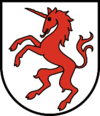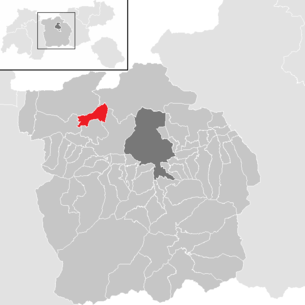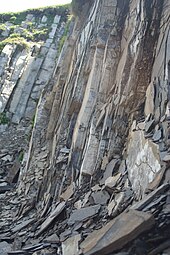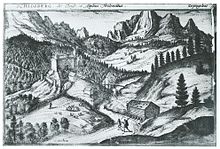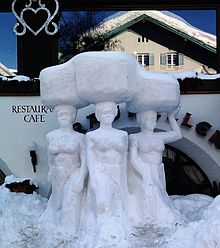Seefeld in Tyrol
|
Seefeld in Tyrol
|
||
|---|---|---|
| coat of arms | Austria map | |
|
|
||
| Basic data | ||
| Country: | Austria | |
| State : | Tyrol | |
| Political District : | Innsbruck country | |
| License plate : | IL | |
| Surface: | 17.37 km² | |
| Coordinates : | 47 ° 20 ' N , 11 ° 11' E | |
| Height : | 1180 m above sea level A. | |
| Residents : | 3,462 (Jan 1, 2020) | |
| Postal code : | 6100 | |
| Area code : | 05212 | |
| Community code : | 7 03 51 | |
| NUTS region | AT332 | |
| UN / LOCODE | AT SEE | |
| Address of the municipal administration: |
Klosterstrasse 43 6100 Seefeld in Tirol |
|
| Website: | ||
| politics | ||
| Mayor : | Werner Frießer ( ÖVP ) | |
|
Municipal Council : (2016) (15 members) |
||
| Location of Seefeld in Tirol in the Innsbruck-Land district | ||
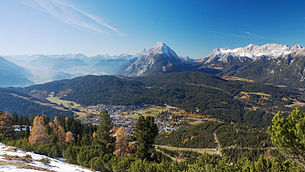 View from the Härmelekopf to Seefeld. In the background on the left the Inn Valley , in the middle the Mieminger Mountains and on the right the Wetterstein Mountains |
||
| Source: Municipal data from Statistics Austria | ||
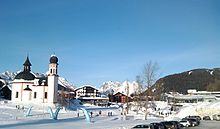

Seefeld in Tirol is a municipality with 3462 inhabitants (as of January 1, 2020) in the Innsbruck-Land district in Tyrol ( Austria ). The place is located on a plateau between the Wetterstein Mountains and Karwendel on an old road from Mittenwald to Innsbruck that has been important since the Middle Ages . First mentioned in a document in the second half of the 11th century and a place of pilgrimage since the 14th century , Seefeld benefited not only from the visits of numerous pilgrims , but also from the right to settle as a trading post between Augsburg and Venice . Also since the 14th century, Tyrolean stone oil has been extracted and widely traded in the village . Seefeld was already popular as a holiday destination before 1900 and, as a well-known winter sports center, has been one of the most popular tourist destinations in Austria since the 1930s . The municipality, which has hosted the Olympic Winter Games several times , is located in the judicial district of Innsbruck and is the hometown of Anton Seelos , the inventor of the parallel swing .
geography
Seefeld is located around 17 kilometers northwest of Innsbruck and around 10 kilometers from the German border on the Seefeld plateau , which is surrounded by the Mieminger chain , the Wetterstein mountains and the Erlspitz group , the most south-westerly part of the Karwendel .
Neighboring communities
In the northwest, Seefeld borders on Leutasch (district Weidach ), in the northeast on Scharnitz (district Gießenbach). The eastern municipal boundary to Zirl runs over the ridge of Seefelder Joch and Seefelder Spitze. In the south is Reith (district Auland) and in the west Telfs (district Mösern ).
Distances
|
Ulm 150 km |
Augsburg 120 km |
Munich 95 km |
|
Bregenz 110 km |

|
Salzburg 150 km |
|
St. Moritz 140 km |
Bolzano 95 km |
Innsbruck 17 km |
topography
That at about 1200 m above sea level. A. Located Seefeld Plateau , which the Tyrolean mountain range is counted, approximately 4 km southeast of Seefeld falls on line reservations - Mösern - Zirler Berg lying steeply to 600 meters below the Inn valley from. The depression around the Seefelder Sattel was created during the formation of the mountains through the lowering of the strata. In the Würm Ice Age, the eastern tongue of the Isar-Loisach glacier , which in turn was an offshoot of the Inn glacier , took care of today's landscape . After the melting of the numerous by filling glacial till sealed cavity molds with water and formed including the eponymous Wildsee on the southern outskirts.
The built-up area extends from the Kirchwald in the west to Seefelder Straße at the foot of the Härmelekopf. In the north it is bounded by the Seebach gorge below the Schlossberg , the parish hill as an extension of the Gschwandtkopf in the south extends to the town center. To the north-east of the village, the municipality extends over the mostly wooded slopes north of the Seefelder Spitze down to the Gießenbach valley. On the border with Scharnitz at the end of the Reiserigklamm lies on the valley floor of the Drahnbach at 1025 m above sea level. A. The lowest point of the municipality, the highest is as the crow flies 3.3 kilometers south-southeast of it on the summit of 2221 m above sea level. A. high Seefelder Spitze.
Waters
The tributaries of the Haglbach arise on the eastern slope of the Seefelder Joch, which runs through the Hermannstal to the west, then turns south along the municipal boundary when it reaches the plateau and feeds the Wildsee . The Wildsee is threatened with silting up by sediment input from the Haglbach. In the future, a pond dredged to the east of Innsbrucker Strasse is to take up these sediments. The runoff of the Wildsee, now called Seebach, runs through Seefeld to the north and takes on the Raabach shortly after the town center. In Peter Anich 1762 this section is recorded as Mühlbach.
The Raabach has its source in the southeast at Möserer Mähder and was formerly dammed into a lake that gave the Seekirchl its name. Below the Schlossberg near the Seebach there is a radon-containing spring, which was first mentioned in 1900 under the name Franz-Josefs-Quelle in the register of health resorts and baths of the KK Lieutenancy for Tyrol and Vorarlberg and which was used as a spa until 1984 . The radon content is rather low at 117 Becquerel per liter (the limit value for drinking water is 1000 Bq / l).
The Klammbach, which rises at the Wildmoosalm below the lake of the same name, runs northwest of the village beyond the Geigenbühel, passes the Triendlsäge (there is a 450 m³ storage pond for a small power plant with 45 kW ) and joins the Lehenwald shortly before the Bodenalm with the Seebach to the Drahnbach. This flows towards Scharnitz and flows into the Isar inflow Gießenbach .
The reservoir at 1578 m above sea level. A. near the Rosshütte ( called Kaltwassersee after the local field name ) holds 66,500 m³ and receives its water from the public supply network. Since 2015 it has also been fed from the Blauer Schrofen spring below the Seefelder Spitze between April and August . The permissible total withdrawal from the cold water lake for snow-making was increased in 2009 from 100,000 m³ to 165,000 m³ per year, and in 2017 to 300,000 m³. In 2016 the application for the addition of bacterial crystallization nuclei ("Snomax") was rejected by the Tyrolean state government.
Land use
Of the 1,738 hectares , 1103 hectares are forested (63.4 percent), 312 hectares are used agricultural and recreational areas (17.9 percent) and 102 hectares are built on (5.9 percent). Water bodies and wetlands take up 13 hectares (0.7 percent) and the remaining 208 hectares are wasteland (12 percent). As a permanent settlement 340 ha are considered (19.6 percent of the municipal area), it is built to 31 percent. The municipality has its greatest extension in the southwest-northeast direction with 8.1 kilometers, in the northwest-southeast direction it is only 1.5 kilometers between Hermannstal and Lehenwald.
The land use according to the CLC data is distributed as follows:

geology
In Seefeld, the main dolomite layers are dominant, which are typical of the Northern Limestone Alps and are part of the Inntal cover. Pfarrhügel and Schlossberg are moraine deposits , as well as the northeast slope of the Geigenbühel, Krinz, the Bodenalm and the ridge of the Rosshütte. The 40 meter high alluvial cone of the Haglbach extends between the main streets of Münchner and Innsbrucker Straße and Seefelder Straße .
A local peculiarity is the kerogenic and bitumen-rich Seefeld Formation , which formed in isolated basins and depressions in the main dolomite lagoon , where water containing hydrogen sulfide near the ground caused fauna to die. These basin facies are up to 650 meters thick. In addition to numerous finds of fossil fish and plants and isolated pterosaurs , the first Langobardisaurus was recently discovered outside of Italy.
The rocks of the Seefeld Formation were mined from around 1350 to 1964 in order to extract Tyrolean rock oil (from 1884 also processed into ichthyol ). The most important mining area was west of the Reither Spitze in the area of the Reither Jochalm .
Found in Seefeld attachment ( " boulders ") come from the Albula Alps ( Julier - granite ) and the Oetztal Alps ( epidote and Granatamphibolit ).
climate
Due to its altitude, Seefeld has a low mountainous climate and is in the montane zone below the alpine zone. The location on the northern edge of the Alps ensures abundant rainfall in low pressure areas (north-west facing ) coming from the Biscay , on the other hand the Wetterstein massif also accumulates the clouds, so that the Seefeld plateau can often still lie in the sun despite the approaching bad weather. There are also foehn layers (highest measured temperature in October: 23 ° C).
The average temperature is 5.1 ° C, the annual precipitation 1165.3 mm. The warmest months are July and August with an average of 14.3 and 13.8 ° C and the coldest January and February with an average of −3.2 and −2.8 ° C. On February 2, 1956, the thermometer in Seefeld fell to −32.5 ° C, which is the cold record for Tyrol. The lowest temperature since 1975 was also recorded in February at −27.4 ° C, the highest in July at 32.2 ° C. The months with the most sunny days (cloudiness below 20 percent) are December to February, the fewest cloudy days (cloud cover over 80 percent) are in October.
The wettest month is July with an average of 153.4 mm, the driest is October with 64.8 mm. In winter more than 4 meters of fresh snow falls, 110 days a year the snow cover reaches 20 centimeters or more. The probability of a white Christmas is 85 percent, and that of snowfall on Christmas Eve is 25 percent.
| Seefeld in Tyrol | ||||||||||||||||||||||||||||||||||||||||||||||||
|---|---|---|---|---|---|---|---|---|---|---|---|---|---|---|---|---|---|---|---|---|---|---|---|---|---|---|---|---|---|---|---|---|---|---|---|---|---|---|---|---|---|---|---|---|---|---|---|---|
| Climate diagram | ||||||||||||||||||||||||||||||||||||||||||||||||
| ||||||||||||||||||||||||||||||||||||||||||||||||
|
Average monthly temperatures and precipitation for Seefeld in Tirol
Source: ZAMG , 1975-2000
|
|||||||||||||||||||||||||||||||||||||||||||||||||||||||||||||||||||||||||||||||||||||||||||||||||||||||||||||||||||||||||||||||||||||||
history
The remains of pile dwellings found in the peat near Seefeld and an amber pearl indicate that there was a settlement on one of the Bronze Age amber roads on the Seefeld plateau . The old trade route was established after the conquest of the Alpine foothills by Drusus and Tiberius in 15 BC. Chr. As a cart path over the Brenner ( per Alpes Norias ) and the Seefelder Sattel laid out or used. The route over the Seefeld plateau was paved in the second century AD under Septimius Severus to the Roman road and led as Via Raetia from Pons Drusi ( Bozen ) via Veldidena (Innsbruck- Wilten ) to Augusta Vindelicorum ( Augsburg ). For the time of Theodoric the Great , Cassiodorus describes in his Variae the Breonen resident in the Inn valley as border guards at the Scharnitz Pass .
middle Ages
The area on the plateau was known as Scharnitzwald through the Scharnitz monastery near Mittenwald , founded in 763 . The first mention of Seefeld ( "Seuelt" ) took place in the years 1073-1078 in a record of the Freising Monastery of the border in Werdenfelser Land .
With the construction of a bridge over the Inn by the Counts of Andechs around 1170, Innsbruck's ascent to a trading center and the revival of the old highway as Via Imperii began . Monks of the Benediktbeuern monastery settled farmers on the Seefeld plateau from around 1180 after they had received a forest area from the Andechs and cleared it. To secure the trade route ( Innsbruck's town charter was documented in 1239 ), Schlossberg Castle ( Lage ) was built in 1248 at the narrow point in the north of the settlement , the keeper of which was the lower jurisdiction .
In 1284 the castle passed from the Counts of Eschenlohe to the Counts of Tyrol and formed the border fortifications to the County of Werdenfels . The church division also followed this boundary: Scharnitz belonged to the diocese of Freising , Seefeld and Oberleutasch to the diocese of Brixen . Nevertheless, the County of Werdenfels tried to maintain territorial claims up to the outskirts of Seefeld, citing the diocese borders from 1060 and its own border descriptions. The goal of Tyrol, on the other hand, was to move the state border to the north towards the strategically important Scharnitz Pass .
The award of the Wegbaues " in the Scharnitz " to the city of Innsbruck (thus preserving the road against Wegzoll ) in 1332 brought Seefeld settlement rights : it was built a ball (s) house and Seefeld was station Rodfuhrwesens at the "lower road "(The" upper road "led over Fernpass and Reschenpass ). The mining for the extraction of Tyrolean stone oil was first mentioned in a document in 1350. According to legend , it was the blood of the giant Thyrsus , which is why it was sold under the name Dürschöl and the dealers were called Dirschler .
When the Tyrolean War of Succession broke out in 1335, the castle was additionally fortified as an important border fortress and the costs for it were collected by a tax nova . Despite these precautions, the castle was conquered by Bavarian troops in 1365 and 1368, but could be recaptured a little later by a Tyrolean contingent. In the Schärdinger Peace of 1369, the castle was returned to the then still jointly ruling dukes Albrecht and Leopold of Austria.
On Maundy Thursday, 1384, the miracle of the Host of St. Oswald is said to have occurred. The legend reports that the knight Oswald Milser, at that time the caretaker at Schlossberg Castle, in his arrogance, demanded communion from the pastor in the form of the large host reserved for the priest. As soon as the host touched his tongue, he sank to the ground up to his knees. The knight regretted his act and there were bloody marks on the wafer. This event triggered a much-attended pilgrimage , which was also promoted by the sovereigns. The rush of pilgrims was so great that Duke Friedrich IV had a larger church built from 1423–31. The bloody host was shown and venerated well into the 20th century.
By 1430, 6500 freight wagons were already using the route via Seefeld each year, 90 percent of the land traffic between Augsburg and Venice. Duke Siegmund der Münzreich arranged for the toll levied on the barrier at the southern end of the village to go to the Seefeld parish and no longer to the state government. He also had a 30 hectare lake that was drained again around 1808 and after which the Seekirchl is named. The artificial dam of the drain or water body (called Kreuzsee location ) was removed only in 1975 during the construction of the sports and convention center.
Modern times
The expansion of the Kuntersweg to the Fahrstrasse in 1480 enabled Siegmund the rich in coins to relocate the important Bolzano markets to Mittenwald from 1487 after the war against the Republic of Venice . As a result, the traffic across the Seefeld Saddle increased sharply and the 1485 establishment took a Faktorei the Fugger in Innsbruck helped that the road from Augsburg via Seefeld, Innsbruck and Brenner to Verona remained the most important trade route between northern Italy and Bavaria and still dwarfed the "upper street". Probably due to financial dependence on Georg Gossembrot , the lord of the castle of Ehrenberg near Reutte , Siegmund issued an instruction in 1488 to transport goods to Augsburg via Telfs and the Fernpass and no longer via the Zirler Berg and Scharnitz.
In return, the completion of Kesselbergstrasse near Kochel am See in 1495 improved the connection to Munich , which in 1506 became the sole capital of Bavaria with the Primogeniture Act . The Via Imperii remained an important pilgrimage route ; so is "Seefelt" as a station on the Romweg card of Erhard Etzlaub records dating back to 1500 and Martin Luther stayed on the way back from Rome in March 1511 Seefeld.
On October 20, 1500, Siegmund's successor Maximilian I and Prince-Bishop Philipp von Freising ratified a treaty concluded the year before, which moved the Tyrolean border to the north to within one kilometer of Scharnitz.
In order to maintain and promote the profitable pilgrimage, Maximilian donated the building of a monastery . Its construction lasted from 1516 to 1604 and after completion the abbey was handed over to Augustinian monks . In addition to the timber industry (in 1785 the monastery owned 750 acres of forest) and fishing (in 1782 sixteen hundredweight of fish were fished from the Kreuzsee), a hospice and a brewery were operated.
Archduke Ferdinand of Tyrol signed Schlossberg Castle in 1586 with all the possessions of the Seefeld parish, which was incorporated into the monastery in 1604. There was now only one guard resident at the castle.
In the Thirty Years' War (1618–1648), Seefeld was spared from destruction, not least because of the Porta Claudia fortification built on the Scharnitz Pass in 1633 . After Archduke Leopold V learned of the “miraculous crucifix” on a hunting trip in 1628, he founded a chapel. The rock island in the reservoir was chosen as its location and the Seekirchl was almost completed by 1632, but the design of the interior dragged on until 1666. The pilgrimage increased again, up to 12,000 pilgrims came to Seefeld in the course of a year.
In 1664, a contract between Count Thurn und Taxis and the Bavarian Elector Ferdinand Maria established a new postal route for the Reichspost from Munich via the Seefelder Sattel to Innsbruck. The relocation of the Mittenwald market to Bozen in 1679 and the decline of Augsburg as an economic center as a result of the Thirty Years' War, however, caused the movement of goods to ebb. In the meantime, Tyrol had become a center for canary breeding and in the 18th century a brisk trade developed between Innsbruck, Augsburg and Nuremberg. However, the condition of the road had deteriorated to such an extent that the route via Reutte or through the Achental was increasingly used and in 1775 the taxi post was directed via Kufstein and the Inn Valley.
In May 1783, an eight-day public expulsion of devils from a 15-year-old Ötztal peasant girl in Seefeld caused a stir . Over two thousand onlookers, who had also come from Mittenwald, Reutte and Telfs, followed the procedure in the town, which at the time only had 400 inhabitants. The year before had enlightened oriented Joseph II. , The monasteries as "sources of superstition and religious fanaticism" looked at her, with the abolition of "useless" monasteries started. On July 11, 1783, a court decree declared the division of the Salzburg-Tyrolean association of Augustinian monasteries, so that the Tyrolean association that had now been formed had to be reformed. The Seefeld Monastery, which at that time comprised fifteen priests, one cleric and four lay brothers, was found to be dispensable during the reorganization of pastoral care and was closed on March 6, 1785. The monks left Seefeld in the late summer of 1785 .
The Schlossberg court was incorporated into the Hörtenberg court in 1787, the year in which the Josephine Code was introduced , and which had previously had high jurisdiction for Seefeld.
19th century
The Stams monastery took over the pastoral care and in 1800 bought the property of the abandoned monastery for 27,000 florins. After the Porta Claudia was captured on November 4, 1805 by the French troops under Marshal Michel Ney and General Louis Henri Loison in the Third Coalition War , 800 soldiers were encamped in the village and looted the church and monastery. After Tyrol was ceded to the Electorate of Bavaria in the Peace of Pressburg on December 26, 1805 , secularization was also extended to the newly acquired state territory and the now finally former monastery was sold to two citizens in Seefeld in March 1808 for 23,000 florins. After that, inns and two breweries were operated in the buildings. The Kreuzsee was drained and the more or less successful hop cultivation on the site of the former lake gave the Seefelds their local name "Höpfeler" .
During the Tyrolean uprising on July 31, 1809, soldiers burned down the rectory, the post house and 14 residential buildings and used the church, which, like the former monastery, had been badly damaged as a stable.
In addition to flax production and timber harvesting , collecting ant eggs and selling them on the Innsbruck market as fodder for the canaries traded there was a notable source of income. Peat was also extracted because of its comparatively good calorific value. In 1845, with the founding of the I. Tyrolean asphalt union at Gießenbach, the industrialization of stone oil distillery and asphalt production began . This turned out to be profitable, so that Archduke Maximilian of Austria-Este financed the iron and steel company named after him near Seefeld. The hope of making big profits with the distillation of the popular lamp fuel, petroleum , which began in 1858 , was dashed with the cheaper petroleum made from petroleum, which was imported a little later . The industrial production was given up and from the mid-1860s the stone oil distillery was operated by local residents again. From 1884 onwards, the sulphonation of stone oil laid the foundation for marketing it under the brand name Ichthyol .
With the construction of the railway line between Rosenheim and Innsbruck in 1858 and the Brenner Railway in 1867, the road over the Seefelder Sattel lost its importance. The area became known nationwide through Hermann von Barth's book " From the Northern Limestone Alps " , published in 1874, and in 1876 there were already authorized mountain guides for Seefeld. The Arlbergbahn ensured an increase in tourism from 1883, so that Seefeld was named among the most visited places in autumn 1885. In May 1891 the Post set up a daily bus connection from Zirl via Seefeld to Partenkirchen , and in 1897 a private line connection was added. The Nördlinger Hütte was built in 1898 and the Karwendelhaus in 1908 . In the same year Seefeld is described on a postcard as a “very popular summer resort on the beautiful mountain lake”, two hours away from the Zirl train station and “starting point for the game to Leutasch and the Bavarian Oberland”. Nevertheless, at the beginning of the 20th century, the Seefeld worked almost exclusively in agriculture and forestry, in vehicle transport and in mining for the production and sale of stone oil.
20th century
The construction of the Karwendelbahn in 1912 further improved the connection to Seefeld. As a result, and after the First World War , tourism took off, not least due to the easy accessibility from Munich, which improved with the electrification of the Munich – Garmisch-Partenkirchen railway and the continuous Karwendel train . In the 1920s, skiing also met with increasing interest outside of the mountains, and winter developed into the second holiday season. Several ski schools were founded, the most prominent ski instructor of which was the multiple world ski champion Anton Seelos .
In the 1930s, Seefeld was the place in Tyrol with the most overnight stays after Innsbruck. Of the 200,000 overnight stays in 1932, over 176,000 were due to German holidaymakers (Innsbruck: 407,000 and 183,000) and in the 1932/33 winter season, over 12,000 of the 13,000 tourists were from Germany . Seefeld was hit all the harder by the thousand-mark block : in the winter of 1933/34 only 1,200 guests came, of which 24 (!) From Germany and the number of overnight stays in 1934/35 sank to 125,000. Nevertheless, Seefeld hosted a major sporting event for the first time with the European Figure Skating Championships in 1934 . After the NSDAP was banned in Austria , its local supporters met under the guise of the Jahn gymnastics club and during the “Anschluss” of Austria on March 12, 1938, mountain troops of the Wehrmacht and SS troops made their way to Innsbruck and the Brenner Pass through Seefeld, where they were received with jubilation.
After that - not least because of Anton Seelos' world championship title - tourism developed again and Seefeld was also used as a conference venue, for example for a "physicist camp" held at the beginning of November 1942, in which quantum mechanics and the "ideological effects of the theory of relativity " were included Participants such as Bruno Thüring , Wolfgang Finkelnburg , Werner Heisenberg and Carl Friedrich von Weizsäcker were discussed. After the two air raids on Innsbruck in December 1943, some of the clinics there were relocated to Seefeld.
On April 28, 1945, a train carrying around 1,700 Jewish prisoners from the Dachau concentration camp reached Seefeld as part of so-called “ evacuation transports ” . The railway line was interrupted in Reith so that the prisoners were supposed to march further into the Inn valley on foot. In Mösern, the SS guards received an order from Gauleiter Franz Hofer to turn back, so that the next day most of the group was forced to return to Seefeld in order to be transported back to Mittenwald by train. Some prisoners did not survive the hardships and the dead were buried outside the village on the site of the later forest cemetery.
Ski races were held again as early as 1946, a chairlift was built on the Gschwandtkopf in 1947 and at the end of January 1949 Seefeld hosted the first International Winter Games for the Deaf as well as the Austrian Figure Skating Championships in 1952 . In the 1950s, Seefeld developed into a well-visited holiday destination, not least thanks to the band's promotional trips to Italy, Belgium and the Netherlands. The place was used as a film motif ( “ Yes, yes, love in Tyrol ” ) and from 1954 the Rosshütte ski area was opened up with lifts. The Agricultural College, founded in Grins in 1948 , was relocated to Seefeld in 1950 and existed as a higher federal college for alpine agriculture until 1956, when it moved to Raumberg .
Seefeld, which was previously characterized by alpine skiing , achieved international fame in 1964 as the venue for the Nordic disciplines of the Winter Olympics in Innsbruck . The year before, the biathlon world championship had taken place as a dress rehearsal . Seefeld was relieved of through traffic by a bypass and 105 Karwendelbahn special trains brought 53,000 travelers to the newly built station. The Nordic competitions were also held here at the 1976 Games . In the run-up to this, the Seefelder Straße towards Scharnitz was given a wider, flatter route in 1974 and the Schlossberg with the castle ruins was removed. At the beginning of the 1970s, a pilot system for cable television was set up by Telesystem Tirol and operated by a local family company from 1975 onwards. In 1985 Seefeld hosted the Nordic World Ski Championships , and in 1986 the Taekwondo European Championships took place in the World Cup hall . Because of the lack of snow in Innsbruck, the Nordic disciplines of the Winter Paralympics 1988 were held in Seefeld.
The family series Almenrausch and Powder Snow was shot in 1992 near Seefeld.
21st century
The Air & Style Snowboard Contest, which is very well known in the snowboard scene, was held in Seefeld from 2000 to 2004. The Nordic Combined Double World Cup has been held here since 2004 and was upgraded to the Nordic Combined Triple in 2014 . At the 22nd Winter Universiade 2005, Seefeld was also the venue for several competitions. The fifth stage of the Deutschland Tour 2006 ended with a mountain arrival in the village, in 2008 the Austrian road cycling championships were held .
At the Winter Youth Olympic Games , which were held for the first time in January 2012 , the sports of biathlon , ski jumping , cross-country skiing and Nordic combined were organized in Seefeld. This made Seefeld and Innsbruck three-time Olympic hosts. In June 2014, the FIS awarded the organization of the Nordic World Ski Championships 2019 to Seefeld. The jumping of the Nordic Ski Games of the OPA 2015 took place on the Toni-Seelos-Olympiaschanze , in February 2016 the Kaiser-Maximilian-Lauf was held.
Seefeld village center
Around the church of St. Oswald and the village square there are - apart from the former Augustinian monastery and the rectory - hardly any traditional buildings.
The bypass, which was built for the Olympic Games in 1964 , made it possible to set up a pedestrian zone with over 80 shops and boutiques. Even in winter, bars invite you to linger on the outdoor terraces and the snow bars. There is also a year-round casino .
Some scenes from the Tatort episode 536 Deadly Souvenirs (book: Felix Mitterer ) were filmed on the village square in Seefeld.
Population development
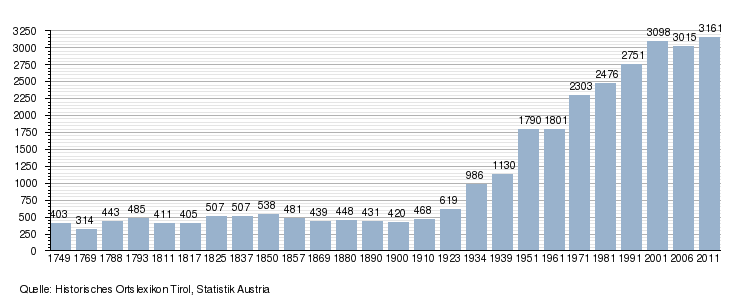
politics
The last mayoral elections took place at the same time as the municipal council elections on February 28, 2016.
Werner Frießer was re-elected mayor. He was the only candidate.
| Political party | percent | be right | Seats on the local council |
Coupling |
|---|---|---|---|---|
| Moving Seefeld - Mayor Werner Frießer | 45.01% | 744 | 7th | A. |
| Seefeld Citizens List - SBL | 33.27% | 550 | 5 | B. |
| Active for Seefeld -AS | 11.98% | 198 | 2 | A. |
| Fresh wind | 9.74% | 161 | 1 | B. |
coat of arms
The municipal coat of arms, awarded in 1946, shows a red, rising unicorn in silver . This is the heraldic animal Oswald Milsers (see Mils bei Hall ), to whom the miracle of the host and thus the once important pilgrimage can be traced back.
flag
The flag of Seefeld is striped red and white (1: 1) and has the municipal coat of arms in the center.
Partner municipality
Seefeld in Tirol has had a partnership with the German city of Salzkotten since 1997 .
Culture and sights
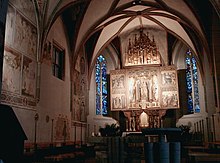
- Parish and pilgrimage church of St. Oswald
- Former Augustinian monastery to the west of the parish church, today a five-star hotel, founded in 1516 by Maximilian I as a hostel
- Rectory, elevated south of the parish church
- Seekirche Hl. Kreuz (Seekirchl) in the west of the village: Landmark of Seefeld, built under Archduke Leopold V by Innsbruck court builder Christoph Gumpp in the Baroque style (construction period 1629–1666), paintings by Josef Anton Puellacher
- Seefeld forest cemetery on the eastern edge of the village with a cemetery chapel and memorial stone for those who died in rail transport at the end of April 1945 from the Dachau concentration camp
- Klause and former castle ruins Schlossberg north of the village
- Milestone , unlabeled, presumably Roman, with a secondary cross carved into it
Infrastructure
Transport links
Rail transport
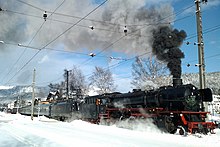
Seefeld is located on the Karwendelbahn , via which the place can be reached from Munich and Innsbruck . There is an hourly ![]() connection to Innsbruck main station or Scharnitz. Every 2 hours a regional express connects Seefeld with the Starnberg wing station in Munich. Since the 2010 winter timetable, Seefeld station has been the highest ICE station in Europe. At the weekend, a pair of ICE trains stops here on the way from Hamburg-Altona via Berlin to Innsbruck.
connection to Innsbruck main station or Scharnitz. Every 2 hours a regional express connects Seefeld with the Starnberg wing station in Munich. Since the 2010 winter timetable, Seefeld station has been the highest ICE station in Europe. At the weekend, a pair of ICE trains stops here on the way from Hamburg-Altona via Berlin to Innsbruck.
Bus transport
Three bus lines of the Verkehrsverbund Tirol and one long-distance bus line stop in Seefeld :
| line | Line designation | Line course |
|---|---|---|
| 4184 | regiobus Tirol | Seefeld / Tirol - Leutasch - Oberleutasch - Book |
| 4186 | regiobus Tirol | Seefeld / Tyrol - Gießenbach - Scharnitz - Mittenwald - Leutasch - Seefeld / Tyrol - Reith - Leithen |
| 8354 | regiobus Tirol | Seefeld / Tyrol - Mösern - Telfs |
| 040 | MyFernbus | Innsbruck - Seefeld (Rosshütte) - Garmisch-Partenkirchen - ZOB Munich (Hackerbrücke) - Munich Airport |
Road traffic
You can reach Seefeld by car via Seefelder Straße B 177, which leads from Zirl over the Zirler Berg to Scharnitz or Mittenwald . Another road connection from the Inn Valley leads from Telfs via Mösern, while Mittenwald can also be reached via the road to Leutasch , bypassing the Scharnitz Pass .
The Innsbruck airport is located about 20 km from Seefeld. In winter there are direct scheduled flights u. a. from Hamburg , Berlin , Düsseldorf and Frankfurt , and daily to and from Amsterdam , Eindhoven and Rotterdam , London , Moscow and Vienna .
Supply and disposal
The water supply is largely fed by the abundant "Eppzirler Quellen" in the Gießenbach valley on the northeastern border of the municipality. The wells built or expanded in the 1950s and 1960s on the Seewiese between the football and tennis facilities and on the Wildsee are only used for the emergency water supply or for service water (snow-making on the ski slopes and cross-country ski trails, watering the ice rink and soccer fields and the ski jump area) .
One of the first fully biological sewage treatment plants in Austria was built for the 1964 Olympics and expanded in 1974. At the end of the 1990s, plans began to expand from 10,000 to 26,000 population equivalents . In 2005, Austria's first wastewater power plant was built for around 12 million euros: the clarified water is no longer diverted to the Isar, but pumped to the Zirler Berg and the slope to the Inn valley with a height difference of around 600 m is used to operate a turbine . Depending on the volume of wastewater, water is also taken from the Seebach in order to achieve an even flow. Of the 5.5 million kilowatt hours of annual working capacity, 0.5 GWh is used for wastewater treatment and 1.5 GWh for the pumping station, so that the net generation of 3.5 GWh roughly corresponds to the needs of all private households in Seefeld.
Ortswärme Seefeld GmbH (owner of the Seefeld municipality) has been supplying the town with district heating from biomass since the end of 2007 . Initially, around four million liters of heating oil were saved each year. In the meantime, more than half of Seefeld's heat requirements are covered by the biomass heating plant and 10,500 tons of CO 2 are avoided every year .
Communication and telecommunications
The pilot plant of Telesystem Tirol for cable television was in 1975 by one in Auland taken based family business. Today around 900 participants in Seefeld and Reith are connected. DVB-T is broadcast by a transmitter on the Gschwandtkopf.
Broadband internet and LTE with up to 150 Mbit / s is available in the entire permanent settlement area of Seefeld . It is unbundled DSL with symmetrical bandwidth of up to 20 Mbit / s available, ADSL to 30 Mbit / s. Broadband internet is also offered via the cable network. Free WiFi access has been available since August 2012 in the pedestrian zone with the spa park, at the sports and congress center, around the Seekirchl and at the casino arena around the ski jumps on the Gschwandtkopf and at some stations in the Rosshütte ski area .
Sports facilities
Seefeld has expanded and renewed its sports facilities in recent years and is positioning itself as a Nordic competence center for training national teams and clubs as well as the Stams ski school .
- Toni Seelos Olympic hills in the Casino Arena on the northwest slope of the Gschwandtkopf ( HS 109 and HS 75)
- Biathlon facility with 30 shooting ranges
- 279 km of trails for cross-country skiing , 125 km of which for skating and 154 km for classic style
- asphalted roller-ski route 3.6 km long and 3 m wide with variants from 560 m to 4.7 km
- FIS - homologated race tracks for slalom and giant slalom on the Gschwandtkopf
- Ski areas Rosshütte, Gschwandtkopf and Geigenbühel / Birken lifts
- Artificial ice rinks for ice skating and curling
- Two grass pitches for soccer , another is planned
- World Cup hall with 8 tennis courts and 4 outdoor courts
- Seefeld tennis club with 6 clay courts
- Golf courses: Seefeld-Reith Golf Club (9-hole, par 70) and panoramic golf course on the Geigenbühel, an 18-hole course is in Wildmoos (Telfs)
- 266 km of signposted running and Nordic walking trails
- 570 km cycling - and mountain -Strecken
- Beach volleyball court
- Two riding halls with outdoor spaces
- Gym & Physiotherapy
Numerous club and national teams have already held soccer training camps in Seefeld, for example the Netherlands in preparation for the 2010 World Cup or the English champions Manchester City in 2012 . The European indoor tennis championships for seniors , which were held for the 38th time in 2014, are the largest indoor tournament in Europe with more than 650 participants from over 30 nations.
Public facilities
- Library
education
- New Seefeld Middle School
- Seefeld primary school
Others
Events with up to 2,000 visitors can be held in the World Cup hall . The Olympia Sports and Congress Center in Seefeld has conference halls with a total of 450 m² as well as the Cinepoint cinema , which in May 2013 introduced the first HFR - 3D projector with 60 frames per second (which corresponds to the "higher frame rate" of James Cameron's film projects ) as well as with 4K resolution for 2D in Austria.
economy
tourism
Two five-star hotels and 27 four-star hotels are available in Seefeld . If you add the hotels in the Olympiaregion Seefeld, there are four five-star hotels and 39 four-star hotels , which results in one of the highest four and five-star hotel densities of all Austrian regions. There are currently around 8,100 guest beds in Seefeld and around 15,000 in the Olympiaregion.
Seefeld is visited by a wide international audience. The result is the following ranking (according to overnight stays) according to the most important nations for 2012: Germany, Switzerland / Liechtenstein, Italy, Great Britain, Netherlands, Austria, France, Belgium, Russia, USA.
| year | Overnight stays | year | Overnight stays | year | Overnight stays | ||
|---|---|---|---|---|---|---|---|
| 1951 | 147,486 | 2000 | 1,130,000 | 2008 | 1,039,536 | ||
| 1956 | 358,382 | 2001 | 1,148,520 | 2009 | 993.441 | ||
| 1961 | 606.905 | 2002 | 1,114,022 | 2010 | 1,032,461 | ||
| 1966 | 825.139 | 2003 | 1,087,431 | 2011 | 1,000,084 | ||
| 1971 | 1,030,048 | 2004 | 1,087,360 | 2012 | 1,035,647 | ||
| 1976 | 1,124,825 | 2005 | 1,102,164 | 2013 | 1,092,440 | ||
| 1980 | 1,257,432 | 2006 | 1,084,839 | 2014 | 1,043,577 | ||
| 1992 | 1,370,000 | 2007 | 1,053,992 | 2015 | 1,133,751 |
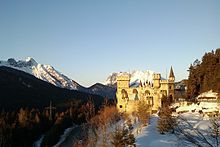
Since the Seefeld Plateau receives a lot of fresh snow in winter with north currents and, due to its topographical and microclimatic conditions, is also referred to as Siberia of Tyrol (daytime temperatures below −20 ° C are not uncommon), the region is considered to be extremely snow-sure.
The two alpine ski areas in Seefeld are connected by a free ski bus. The slopes in the northeast on Seefelder Joch and Härmelekopf are operated by Bergbahnen Rosshütte Seefeld-Tirol-Reith AG (main shareholder: Seefeld municipality with approx. 95 percent stake) with a total of nine lifts (including three 6- seater chairlifts with wind protection, two of them with heated seats , a funicular , two aerial tramways and three drag lifts ), the Gschwandtkopf south of Seefeld is accessible by eight privately operated lifts (one 4-seater chair lift, one single chair lift, drag lifts). These ski areas are largely independent of snow: the slopes of the Rosshütte are 100% snowable with energy-saving HKD snow lances and from their own storage lake , while those of the Gschwandtkopf can also be almost completely snowed using low-pressure propeller snow-making from the public water supply.
In addition, the Geigenbühellift and the Birkenlifts (both drag lifts) are located in the immediate vicinity of the town center .
Even in winter, many guests do not come to Seefeld exclusively for skiing / cross-country skiing, but also because of the wide range of activities away from the slopes: horse-drawn sleigh rides, ice stock sport, ice skating, snowshoeing, tobogganing, snow fun sports (snow rafting), large adventure pool (Olympic and congress center) with indoor and outdoor pool, 140 m white water and 110 m SilverStar family slide and a spacious sauna area. Over 140 km of hiking trails are groomed in winter, the summer network covers over 650 km. Over 266 km of routes for running and Nordic walking are open to sports enthusiasts in the warm season, 70 km of winter routes are available. The route network for cyclists covers 570 km.
Starting from the spa park, a geology educational trail leads through the Hermannstal, which introduces boulders from the region deposited by the Ice Age glaciers and describes their origin. The Kaiser-Maximilian-Weg around the Wildsee provides information on eleven boards about the lake, moor, flora and fauna and the climate on the Seefelder Sattel. The place also has a casino , three Kneipp facilities, two mini golf courses, a yoga center in the Hotel Klosterbräu and three discos.
Since 1969, the flower parade with figures made of flowers has taken place on the first Sunday in August, in winter artists model larger-than-life snow sculptures for the snow festival held on the last weekend in January.
Seefeld is one of the few Austrian holiday resorts with a balanced winter and summer season (over 500,000 overnight stays in summer 2010). The place is a member of Best of the Alps . In this association, qualitatively leading holiday resorts in the Alpine region (Germany, Austria, Switzerland, Italy, France) have come together. In Austria, Lech / Zürs, Kitzbühel and St. Anton also belong to this union.
The 279 km of trails in the Olympiaregion Seefeld are considered the cross-country skiing Mecca in Europe and have been awarded the title Best Cross-Country Ski Area 2007 by the ADAC . In the readers' poll of the DSV Atlas Ski, the area of the Olympiaregion Seefeld was awarded first place out of 232 areas nominated worldwide in the category of excellent trails . The cross-country skiing area is located at an altitude between 1,180 m and 1,550 m, the level of difficulty ranges from easy to difficult. There is a 3 km long night trail between Seefeld and Mösern. After Leutasch, Seefeld was one of the first communities to introduce a trail fee.
The PlayCastle in the north of Seefeld, built in 1998 as an "interactive adventure castle ", was closed again after only one year of operation. As a result, various usage concepts failed. For 2012, the owner, the former investor in Cosmos , who has existed since 2007, announced the reopening. After a pre-opening in April, a club was operated on weekends in May 2013 , after which there were only sporadic events. The future is still uncertain what should happen to the Playcastle, an event center was planned that was also approved, it is not certain when and whether it will go into operation from the current state of affairs.
Together with its neighboring towns, Seefeld organizes the International 3-Day Einhormarsch , a three-day popular hike that takes place annually on the third weekend in September. The organizer is the "Tourismusverband Olympiaregion Seefeld". The Volkswanderung has been the Austrian contribution to the IML Walking Association since 1987 .
Olympiaregion Seefeld
Seefeld and its neighboring towns of Leutasch , Reith bei Seefeld , Mösern , Buchen and Scharnitz form the Olympiaregion Seefeld .
Personalities
Sons and daughters from Seefeld in Tirol
- Johann Baptist Schöpf (1824–1863), linguist
- Walter Delle Karth Sr. (1911-2004), Nordic skier
- Anton Seelos (1911–2006), ski racer and ski trainer
- Johann Seelos (1914–1945), ski racer
- Paul Haslwanter (1915–1992), cross-country skier
- Luis Seyrling (1923-2001), ski racer
- Regina Schöpf (1935–2008), ski racer
- Veronika Bennholdt-Thomsen (* 1944), ethnologist and sociologist
- Manfred Gabrielli (1944–2005), sports journalist
- Wilhelm Grissemann (* 1944), politician
- Tilmann Märk (* 1944), physicist
- Jan-Carl Raspe (1944–1977), co-founder of the RAF
- Maresa Hörbiger (* 1945), actress
- Florian Liewehr (1945–2014), actor
- Giselher Smekal (* 1945), musician and radio host
- Rudolf Wanner (* 1951), ski jumper
- Hannes Schönegger (* 1970), co-founder of the TTR World Snowboard Tour
- Martin Tauber (* 1976), cross-country skier
- Gregor Glanz (* 1979), pop singer
Well-known residents of Seefeld
- Karl Mühlberger (1857–1944), director of the Seefeld Citizens Music Band from 1928 to 1933.
- Erwin von Lahousen (1897–1955), secret service officer and witness in the Nuremberg trial of major war criminals
- Friedrich Wilckens (1899–1986), composer and pianist
- Harald Kreutzberg (1902–1968), dancer
- Lilly von Sauter (1913–1972), writer
- Heinz Haber (1913–1990), physicist and founder of Bild der Wissenschaft
- Robert Jungk (1913–1994), publicist and futurologist, in exile from March to May 1933.
- Egon Schöpf (* 1925), ski racer
- Dagmar Rom (* 1928), ski racer
- Rudolf Dietrich (1929-2004), ski jumper
- Willi Köstinger (1940–2014), ski jumper and Nordic combined athlete
- Michael Halhuber-Ahlmann (* 1947), psychologist and educator
- Carola Dertnig (* 1963), artist
- DJ Ötzi (* 1971), entertainer and pop musician
- Dario Đaković (* 1987), football player
Web links
- 70351 - Seefeld in Tirol. Community data, Statistics Austria .
- Seefeld , in the history database ofthe association "fontes historiae - sources of history"
Individual evidence
- ↑ Otto Ampferer : Across the southern edge of the Lechtal Alps between Arlberg and Ötztal. In: Yearbook of the Federal Geological Institute, Volume 80, Issue 3 and 4, year 1930, p. 409. ( PDF, 1.69 MB ).
- ↑ Josef Hornsteiner: Last chance for the Wildsee? , plateauzeitung.at of February 4, 2014.
- ↑ spa T20956563R3 / QU70351005 , part excerpt from the water carrying Tirol.
- ↑ Brief report - former Hotel Schneeweiss. ( Memento from July 24, 2013 in the web archive archive.today ) District Court Innsbruck, 811 20 E 84 / 12k, accessed on July 24, 2013.
- ↑ Mag. Helmut Pintarelli: Expert opinion on the market value, former Hotel Schneeweiss (transaction number: 20 E 84 / 12k). of December 13, 2012, p. 12f. ( PDF ( page no longer available , search in web archives ) Info: The link was automatically marked as defective. Please check the link according to the instructions and then remove this note. , 228 kB)
- ↑ Beck reservoir no. 1) T20542888R3 , 3/4 "Triendlsäge" small hydropower plant T20542844R3 Partial extracts from the Tyrolean water book .
- ↑ 3/3108 Snow-making system "Roßhütte - Härmelekopf - Reitherjochalm" T20608870R3 , partial excerpt from the Tyrolean water book.
- ↑ ( page no longer available , search in web archives ) permanent settlement area of the municipalities, territorial status 2013, Statistics Austria ( PDF , 133 kB) and Tirol Atlas , data from Statistics Austria, 2001 and 2002.
- ↑ Corine Land Cover on tirolatlas.at
- ^ Geological map of the Republic of Austria 1: 50,000; No. 117 (1992) ( PDF , 2.1 MB)
- ↑ Sensational dinosaur find in Tyrol. In: Courier . April 19, 2013, accessed May 9, 2013.
- ^ Franco Saller, Silvio Renesto, Fabio M. Dalla Vecchia: First record of Langobardisaurus (Diapsida, Protorosauria) from the Norian (Late Triassic) of Austria, and a revision of the genus. In: New Yearbook of Geology and Paleontology - Treatises. Volume 268, Number 1, April 2013, pp. 83-95. doi: 10.1127 / 0077-7749 / 2013/0319
- ↑ Climate data Austria 1971–2000 , ZAMG
- ↑ Cold: record of minus 37.4 degrees unaffected. In: Salzburger Nachrichten . January 31, 2012, accessed December 27, 2016.
- ↑ Every year again: “White Christmas?” on Vorarlberg online, vol.at, December 13, 2011 (data from Alexander Orlik, ZAMG ).
- ↑ Remnants from antiquity. In: Innsbrucker Nachrichten. January 29, 1873, p. 4.
- ↑ Robert von Srbik : Overview of mining in Tyrol and Vorarlberg in the past and present. Innsbruck 1929 (special reprint from the reports of the Natural Science-Medical Association Innsbruck), p. 123ff. (online at haben.at)
- ↑ Rupert Breitwieser, Andreas Lippert : Pass routes of the Celtic and Roman times in the Eastern Alps . In: Mitteilungen der Anthropologische Gesellschaft in Wien , 129 (1999), p. 127.
- ↑ Franz Ramsauer: Alpine customer in the Middle Ages. In: Nature and Culture. 12th year, issue 21/22, August 1, 1915, pp. 507-515. (online at haben.at)
- ↑ Martin Bitschnau , Hannes Obermair : Tiroler Urkundenbuch, II. Department: The documents on the history of the Inn, Eisack and Pustertal valleys. Volume 1: By the year 1140 . Universitätsverlag Wagner, Innsbruck 2009, ISBN 978-3-7030-0469-8 , p. 217-218, no. 245 . - On the other hand, the alleged first mention of Seefeld in a document from the Wiltens monastery from 1022 on the website of the Seefeld municipality, Numbers and History , cannot be verified . accessed on Nov. 6, 2016.
- ↑ County Werdenfels - extent and boundaries of the county: The Tyrolean border. In: Old Bavaria. Row I issue 9:. Werdenfels county. Komm. Für Bayerische Landesgeschichte, Munich 1955, p. 15.
- ^ A b Daniel-Erasmus Khan: The German state borders - legal-historical foundations and open legal questions. Mohr Siebeck , 2004, ISBN 3-16-148403-7 , p. 211 f. (Preview on Google Books)
- ↑ Otto Stolz: German Customs Tariffs of the Middle Ages and Modern Times 1: Sources on the history of customs and trade in Tyrol and Vorarlberg from the 15th to the 18th century. (= German trade files of the Middle Ages and modern times. 10). Wiesbaden 1955, cit. after Thomas Kühtreiber : Street and Castle. Notes on a complex relationship. In: Kornelia Holzner-Tobisch, Thomas Kühtreiber, Gertrud Blaschitz (eds.): The complexity of the street. Continuity and change in the Middle Ages and early modern times (= publications by the Institute for Reality Studies of the Middle Ages and Early Modern Times. 22). Vienna 2012, p. 286, FN 61.
- ↑ see text on the special exhibition The Rodfuhr - with goods and salt over the passes ( memento of the original of April 13, 2014 in the Internet Archive ) Info: The archive link was inserted automatically and has not yet been checked. Please check the original and archive link according to the instructions and then remove this notice.
- ↑ How Haymo killed Thyrsus , haben.at
- ^ Josef Riedmann: Friede von Schärding, September 29, 1369. In: Historisches Lexikon Bayerns . (June 29, 2012).
- ↑ a b The world-famous wonder in Seefeld. ( Memento from April 28, 2012 in the Internet Archive ) Text from 1884 (?), Archived from the original on April 28, 2012.
- ↑ The incident with Oswald Milser , haben.at
- ↑ The Miracle of Seefeld , say.at
- ^ Parish Seefeld: Parish Church St. Oswald
- ^ Inge Dollinger: Tyrolean pilgrimage book . Tyrolia - Athesia, Innsbruck - Bozen 1982, ISBN 3-7022-1442-9 , p. 43 .
- ^ Martin Kluger: The Fugger in Augsburg. ISBN 978-3-939645-63-4 , p. 13. ( Reading sample ; PDF, 1 MB)
- ^ Thomas Kühtreiber: Street and Castle. Notes on a complex relationship. In: Kornelia Holzner-Tobisch, Thomas Kühtreiber, Gertrud Blaschitz (eds.): The complexity of the street. Continuity and change in the Middle Ages and early modern times. (= Publications of the Institute for Reality Studies of the Middle Ages and the Early Modern Age. 22). Vienna 2012, p. 286.
- ↑ Pirmin August Lindner: The abolition of the monasteries in German Tyrol 1782–1787: a contribution to the history of Emperor Joseph II. P. 256.
- ↑ Pirmin August Lindner: The abolition of the monasteries in German Tyrol 1782–1787: a contribution to the history of Emperor Joseph II. P. 257.
- ↑ The miraculous crucifix , haben.at
- ^ Ludwig Hörmann: Tyrolean bird dealer. In: Der Alpenfreund. Volume 2, Gera 1870, pp. 123f. (online at haben.at)
- ↑ County Werdenfels - On the history of the county. In: Old Bavaria. Row I, Issue 9:. Werdenfels county. Komm. Für Bayerische Landesgeschichte, Munich 1955, p. 7.
- ↑ How the "midday devil" was cast out. say.at. Detailed report in Johann Pezzl: Notes on the devil in Seefeld in Tyrol. Seefeld 1783 (also on Google Books )
- ↑ Andreas Freye: The Josephine reforms in Austria under Maria Theresa and Joseph II. With the focus on church reform. GRIN Verlag , Munich 2007, ISBN 978-3-638-67098-2 , p. 18 ( Google book preview ).
- ↑ The question of usefulness: The monastery tower under Joseph II on habsburger.net
- ↑ Pirmin August Lindner: The abolition of the monasteries in German Tyrol 1782–1787: a contribution to the history of Emperor Joseph II. P. 252 f.
- ↑ Pirmin August Lindner: The abolition of the monasteries in German Tyrol 1782–1787: a contribution to the history of Emperor Joseph II. P. 254 f.
- ↑ Pirmin August Lindner: The abolition of the monasteries in German Tyrol 1782–1787: a contribution to the history of Emperor Joseph II. P. 261 f.
- ↑ District Court Telfs - History on justiz.gv.at, accessed on November 14, 2014.
- ↑ For comparison: a top earner in 1808 was the internationally celebrated soprano Angelica Catalani with 60,000 florins in one season, the Viennese court theater director Franz Ignaz von Holbein received 1,000 florins per year. After the abolition of the monasteries, fathers received 300 florins annually from the religious fund , friars and sisters 150 to 200 florins. The painter Margarethe Geiger received a grant of 30 florins per month in Munich in 1807, which secured her livelihood: the Bavarian councilor Ignaz In 1808, a year with low grain prices, Joseph Edler von Obernberg calculated the daily requirement of an unmarried construction worker to be 43 kreuzers (60 kreuzers = 1 guilder), of which 21 kr. for food. The highest daily wage in summer for journeyman masons in Munich was 52 kr., That for journeyman carpenter 56 kr.
- ↑ Kaiser Maximilian - Ablaßsee on the Seefeld. from prachensky.com, accessed April 11, 2014.
- ↑ Christine Safe (Red.): Klosterleben , in Onrail 5/14 of October 2013, p. 11 ( PDF, 529 kB ).
- ↑ Josef Hirn: Tyrol's survey in 1809. Innsbruck 1909, p. 552 (online on haben.at).
- ↑ Ludwig Hörmann: The Seefeld ant witches. In: Innsbrucker Nachrichten. No. 217, September 21, 1872, supplement. ( also online at haben.at )
- ^ Notices from the German and Austrian Alpine Club. Volume 4, 1878, p. 80.
- ↑ Ludwig Hörmann : Stone oil carrier and stone oil burner. In: Der Alpenfreund. Monthly booklets for the dissemination of alpine studies among young and old in popular descriptions from the entire area of the alpine world and with practical waving for enjoyable tours of the same. HG Dr. Ed. Amthor, Volume 4, Gera 1872, p. 321ff. (online at haben.at)
- ^ Notices from the German and Austrian Alpine Club. Volume 2, 1876, p. 246.
- ↑ From the state capital. In: Tyrolean Foreign Journal. - Organ to increase tourism in Tyrol, Vorarlberg and the Bavarian highlands No. 3/1885, p. 3.
- ↑ Communications of the German and Austrian Alpine Club Volume 17 (1891), p. 96.
- ↑ Communications of the German and Austrian Alpine Club Volume 23 (1897), p. 169.
- ↑ Harald Walser : The illegal NSDAP in Tyrol and Vorarlberg 1933-1938. (= Ludwig Boltzmann Institute for the History of the Labor Movement - Materials on the Labor Movement. No. 28). Europa Verlag, Vienna 1983, ISBN 3-203-50846-X , p. 15f. ( Link or (PDF) , 15.5 MB).
- ↑ Harald Walser : The illegal NSDAP in Tyrol and Vorarlberg 1933-1938. (= Ludwig Boltzmann Institute for the History of the Labor Movement - Materials on the Labor Movement. No. 28). Europa Verlag, Vienna 1983, ISBN 3-203-50846-X , p. 66. ( Link or (PDF) , 15.5 MB).
- ↑ In Tyrol - like the invasion of the Rhineland. In: Reichspost Vienna. No. 72/45. Volume, March 13, 1938, p. 4, accessed on February 1, 2014.
- ↑ Dieter Hoffmann, Mark Walker: Physicist between autonomy and adaptation. John Wiley & Sons , 2012, ISBN 978-3-527-40585-5 , p. 155. ( online at Google Books )
- ↑ Seefeld 1942–1943. Meeting Notes and Reports, Samuel A. Goudsmit Papers, Series IV, Box 25, Folder 12: Alsos Mission , online at the American Institute of Physics website , Niels Bohr Library & Archives ( full list of participants ).
- ^ Leo Unterrichter: The air raids on North Tyrol during the war 1939–1945. In: Publications of the Tiroler Landesmuseum Ferdinandeum. 26/29 (1946/49), pp. 555-581 (PDF, 12.1 MB).
- ↑ a b Memorial sites of National Socialism in Innsbruck and Seefeld. Institute for Contemporary History at the University of Innsbruck 2004.
- ↑ a b The Mittenwaldbahn . In: Kuratorium für Technische Kulturgüter (Red.): Tecneum.eu. accessed on May 6, 2014.
- ^ I International Winter Games for the Deaf on deaflympics.com. accessed on February 1, 2014.
- ↑ Minutes of the parliamentary session of July 15, 1964, p. 2825 ( ( page no longer available , search in web archives ) PDF, 2.4 MB, p. 37)
- ↑ Karl Morgenstern: Where cross-country skiing becomes a cult . In: The time . 17th January 1975.
- ↑ It is amazing how hard these athletes fought for their medals! In: Innsbruck city news. No. 2 1989, p. VIII ( Adobe Flash required).
- ↑ Seefeld receives Nordic World Cup 2019 , APA report on derstandard.at of June 5, 2014, accessed on June 5, 2014.
- ^ State of Tyrol
- ^ Eduard Widmoser: Tiroler Wappenfibel . Tyrolia-Verlag, Innsbruck 1978, ISBN 3-7022-1324-4 , p. 26 .
- ↑ Dehio Tirol 1980 , pp. 719–723.
- ↑ Scheduled flight schedule winter 2016/17 on innsbruck-airport.com (PDF, 32 kB).
- ↑ 3/638 WVA Seefeld T20574859R3 , part excerpt from the water carrying Tirol.
- ↑ Seefeld sewage treatment plant is officially opened. In: Seefelder Rundschau. 07/2006, p. 4. ( PDF, 3.8 MB )
- ↑ Power Plobb, the Seefeld iT sewage power plant ( Memento from January 18, 2014 in the web archive archive.today ) Website of Wasser Tirol GmbH.
- ↑ Seefeld is the sole owner of the district heating. (No longer available online.) September 8, 2015, archived from the original on August 18, 2016 ; accessed on August 18, 2016 . Info: The archive link was inserted automatically and has not yet been checked. Please check the original and archive link according to the instructions and then remove this notice.
- ↑ Bio-Ortswärme Seefeld opened. Energiecomfort GmbH press release of July 11, 2008.
- ↑ Nikolaus Paumgartten: Seefeld local heat is fully developed. In: Tyrolean daily newspaper . December 29, 2010.
- ↑ The cable system. on kabelseefeld.at, accessed on April 26, 2014.
- ↑ Broadband master plan for Tyrol. ( Memento of the original from April 26, 2014 in the Internet Archive ) Info: The archive link was inserted automatically and has not yet been checked. Please check the original and archive link according to the instructions and then remove this notice. Office of the Tyrolean Provincial Government, Economics and Labor Department, 2012 (PDF)
- ↑ Homologations: Seefeld (AUT) on fis-ski.com
- ↑ ManCity moved into quarters in Seefeld. In: Tyrolean daily newspaper. July 9, 2012.
- ↑ 38th International Senior Tennis Championships. ( Memento from April 20, 2014 in the web archive archive.today ) on tirol.at; 38th European Senior Open. on the ITF website .
- ↑ One of the most modern cinemas in all of Europe - in Seefeld! on mein district.at on May 18, 2013, accessed on January 25, 2013.
- ↑ Numbers and history on the homepage of the municipality of Seefeld, accessed on May 23, 2013.
- ^ Tourism: Statistics. ( Memento from June 27, 2013 in the web archive archive.today ) on tirol.gv.at, Seefeld Tourist Office
- ↑ Tourism in Figures - April 2011 edition. ( Memento of the original from February 4, 2012 in the Internet Archive ) Info: The archive link has been inserted automatically and has not yet been checked. Please check the original and archive link according to the instructions and then remove this notice. Austrian Chamber of Commerce, p. 40.
- ↑ Seefeld member profile at Best of the Alps
- ↑ Fred Fettner: Cross-country skiers have to pay. In: The time . January 11, 1991.
- ↑ Kathrin Gulnerits: The interactive adventure castle in Seefeld opens in May. ( Memento from November 5, 2013 in the Internet Archive ) In: Wirtschaftsblatt. January 19, 1999.
- ↑ Play Castle remains a problem child. on: orf.at . February 7, 2006.
- ↑ Philipp Neuner: Bankrupt Castle for ten years in a deep slumber. on: krone.at . October 13, 2010, accessed April 14, 2014.
- ↑ Playcastle is to become an event center. on: orf.at. March 14, 2011, accessed April 14, 2014.
- ↑ Stauder announces a restart in Playcastle for 2012. ( Memento from April 15, 2014 in the Internet Archive ) In: Tiroler Tageszeitung. March 15, 2011 (copy of the original ).
- ↑ Playcastle Events on facebook.com.
- ↑ The fairytale castle has opened again. , In: Plateauzeitung. 12/2013, December 6, 2013, p. 3 ( Adobe Flash required).
- ↑ Denise Daum: The pleasure palace remains a palace in the air. In: Tyrolean daily newspaper. March 30, 2014.
- ↑ Future of Play Castle still open. In: ORF Tirol. ORF Tirol, October 20, 2018, accessed on October 22, 2018 .
- ↑ http://www.imlwalking.org/#/members/Seefeld
